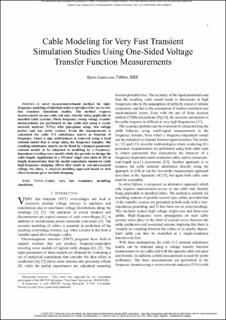| dc.contributor.author | Gustavsen, Bjørn | |
| dc.date.accessioned | 2022-10-05T08:07:58Z | |
| dc.date.available | 2022-10-05T08:07:58Z | |
| dc.date.created | 2022-09-22T12:15:00Z | |
| dc.date.issued | 2022 | |
| dc.identifier.issn | 0885-8977 | |
| dc.identifier.uri | https://hdl.handle.net/11250/3023891 | |
| dc.description.abstract | A novel measurement-based method for high-frequency modeling of shielded cables is introduced for use in very fast transient simulation studies. The method requires measurements on one cable end only, thereby being applicable to installed cable systems. Three frequency sweep voltage transfer measurements are performed at one cable end using a vector network analyzer (VNA) with gain-phase setup, two voltage probes and one series resistor. From the measurements is calculated the cable 2×2 admittance matrix as function of frequency where a sign arbitrariness is removed using a local rational model that is swept along the frequency samples. The resulting admittance matrix can be fitted by a lumped-parameter rational model, or be subjected to modeling by a frequency-dependent traveling wave model which also permits to change the cable length. Application to a 150 mm 2 single core cable of 252 m length demonstrates that the model reproduces measured cable high-frequency damping effects that result in sub-microsecond voltage rise times. A classical modeling approach based on skin effect formulae gives too little damping. | en_US |
| dc.description.abstract | Cable Modeling for Very Fast Transient Simulation Studies Using One-Sided Voltage Transfer Function Measurements | en_US |
| dc.language.iso | eng | en_US |
| dc.publisher | IEEE | en_US |
| dc.title | Cable Modeling for Very Fast Transient Simulation Studies Using One-Sided Voltage Transfer Function Measurements | en_US |
| dc.title.alternative | Cable Modeling for Very Fast Transient Simulation Studies Using One-Sided Voltage Transfer Function Measurements | en_US |
| dc.type | Peer reviewed | en_US |
| dc.type | Journal article | en_US |
| dc.description.version | acceptedVersion | en_US |
| dc.source.journal | IEEE Transactions on Power Delivery | en_US |
| dc.identifier.doi | 10.1109/TPWRD.2022.3208137 | |
| dc.identifier.cristin | 2054297 | |
| dc.relation.project | Norges forskningsråd: 294508 | en_US |
| cristin.ispublished | true | |
| cristin.fulltext | postprint | |
| cristin.qualitycode | 2 | |
